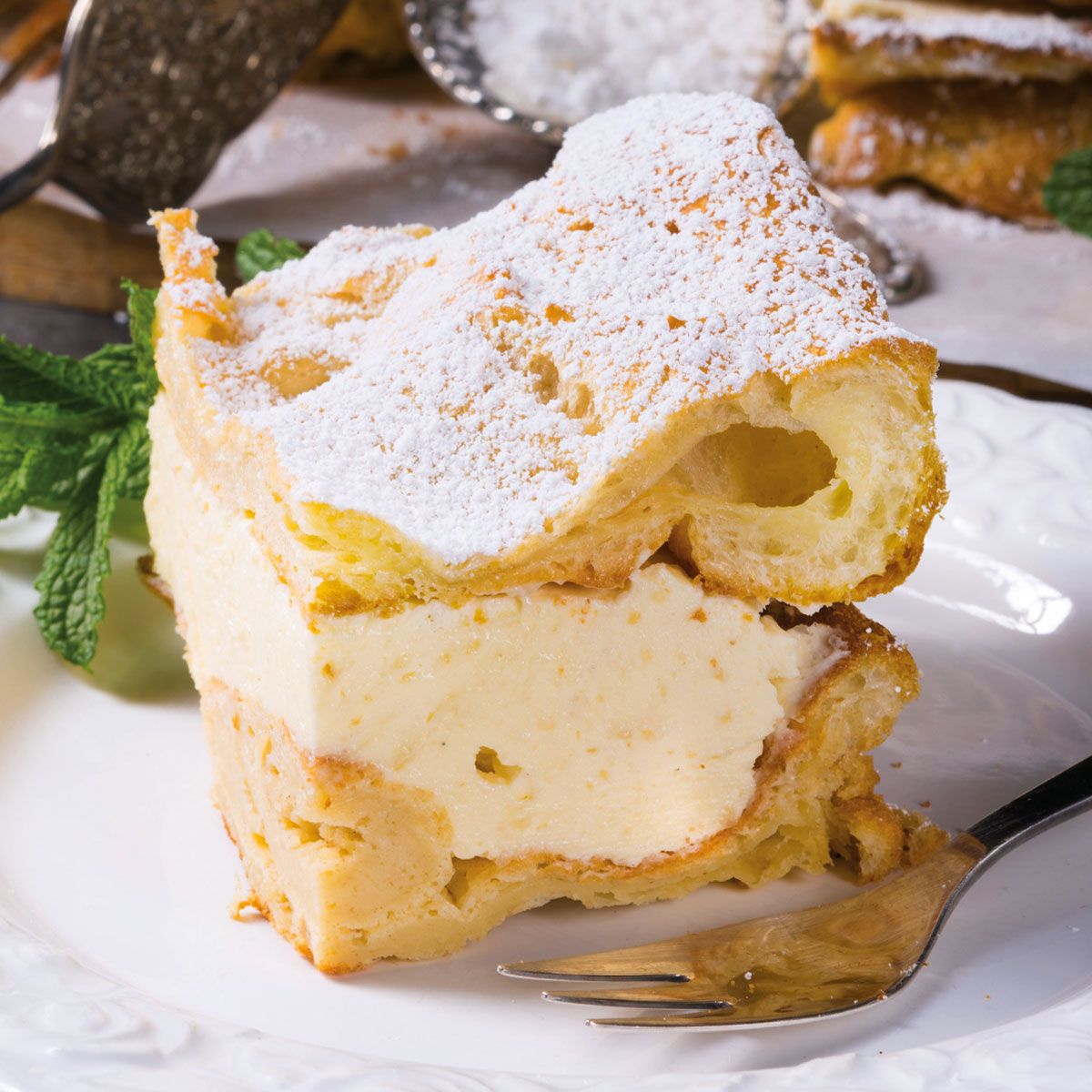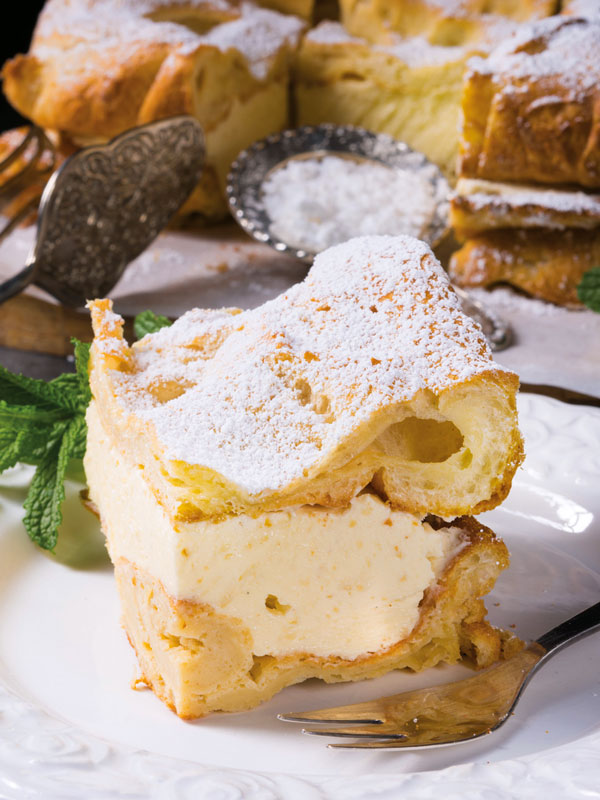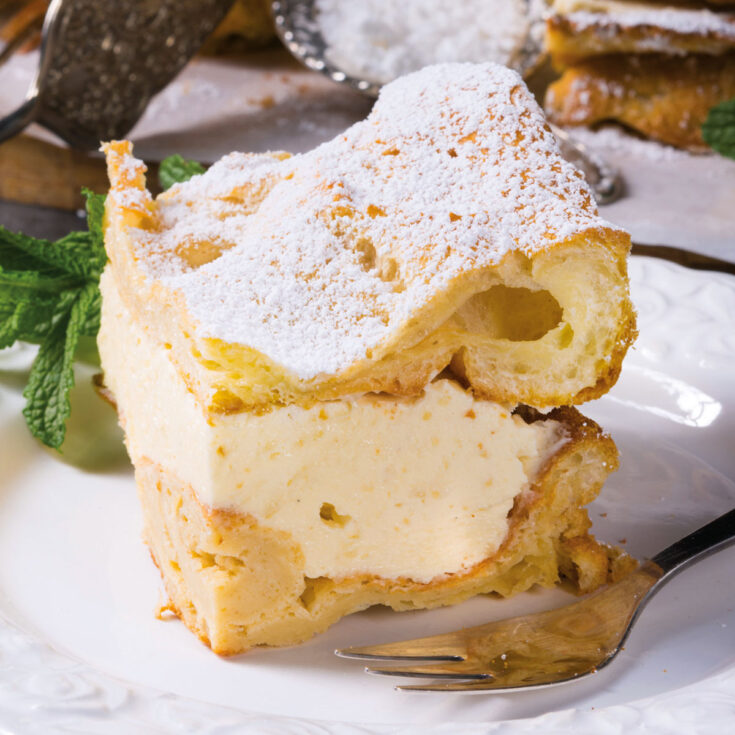Karpatka
Karpatka: Carpathian Cream Cake
How to pronounce it?
car-patkah
‘Play’ to hear:

Karpatka is a popular Polish cake. Two layers of choux pastry are filled with fragrant custard cream. There’s a crunch and there’s velvety softness – a perfect balance.
There are Karpatka baking mixes available in shops in Poland and in Polish stores internationally, but nothing beats the real deal.
For the full list of ingredients & detailed instructions, please see the recipe card at the end of this post. But before you scroll, there’s important stuff to know below.
As the story goes, Karpatka was named after the Carpathian Mountains (in Polish: Karpaty). And you can see why – the pastry is shaped like a mountain landscape viewed from above.
Do you need any special ingredients or equipment to make Karpatka?
In general, all of the ingredients should be easy to get from any major supermarket. There are two ingredients that might be a little troublesome to purchase:
- A sachet (in Poland it contains roughly 16 g, a tablespoon-worth) of vanilla sugar. It’s a popular product in Europe, but elsewhere you can substitute it for one vanilla bean or 3 teaspoons of vanilla extract.
- Potato starch or potato flour. This ingredient is needed for our custard cream. If you can’t find it, skip it (and the regular flour too) and use a pack of powdered custard instead.
Equipment-wise, you’ll need a large rectangular cake tin (ideally 9 x 13 in / 23 x 33 cm) and a mixer (hand-held or a standing one).
What could you serve with this Carpathian Cake?
Karpatka pairs well with warm beverages, such as classic English tea or a coffee of your choice.
Among wines, a semi-sweet or semi-dry sparkling wine balances the creaminess of this cake beautifully. Is it a special occasion? If you’re in Poland, I would recommend trying one of the Polish wines (such as Seyval Blanc from Dwór Sanna Winery). Otherwise, try Moet & Chandon White Star or a Californian Korbel Sec.
Can you make this Karpatka another way?
Some publications mention using a shortcrust base instead of a choux pastry base, but I’ve read that pro-bakers frown upon recipes like these. But hey – if you want to bake it this way, go for it.
You could potentially save yourself some time and use a store-bought instant vanilla custard, instead of making it from scratch.
Nothing tastes like a homemade cake, but there are a few manufacturers who make Karpatka baking kits (for the whole cake or just the cream), you’re likely to find them at Polish delis.
What diets is this Carpathian Cake suitable for?
Karpatka is meat-free, but it does include dairy and eggs (it’s suitable for lacto-ovo vegetarians).
How to store Karpatka?
Once you’ve served it, ideally you should eat it within 2-3 hours.
You can store any leftovers in a cool place, the refrigerator works too. Cover the cake tightly with an aluminium foil (karpatka tends to absorb flavours and smells from other products). Eat within 2-3 days. Warning: The longer you store Karpatka, the soggier it becomes.
If you’re making Karpatka ahead of an event, you can bake choux pastry layers a few days in advance, and store in an air-tight container (or wrap it tightly in an aluminium foil). Make the cream and assemble the cake on the day (in the morning) and store in the fridge.
Can I freeze Karpatka?
Sadly, no. The cream changes its texture in the freezer, and not in a good way.
But you can freeze baked choux pastry layers on their own. As soon as they’re baked and chilled, wrap them in foil and place in the freezer. Remember to label them well, so that you know what it is and when it was frozen. Aim to use these up within 2-3 months.
To thaw, leave them in the fridge overnight and place in the oven for 8-10 minutes at 360°F (180°C), to get rid of any excess water. Make the cream from scratch and assemble the cake.

Karpatka: Carpathian Cake with Custard Cream

A slice of creamy Karpatka for dessert is one of the greatest gifts you can give to yourself.
It's made of two choux pastry layers, hiding some velvety vanilla & custard cream between them. Yum.
Ingredients
For Choux Dough (Enough for 2 layers):
- 1 cup (250 ml) milk
- 1 stick (113 g) butter
- 1 cup (150 g) all-purpose flour
- 5 eggs (medium)
For Vanilla Custard Cream:
- 3 cups (750 ml) milk
- 10 tbsp (130 g) fine/caster sugar
- 1 tbsp (1 sachet, 16 g) vanilla sugar, can substitute for 1 vanilla bean (seeds) or 3 tsp vanilla extract
- 1 egg
- 4 egg yolks
- 4 tbsp (40 g) potato starch / potato flour
- 2-2.5 tbsp (20 g) all-purpose flour
- 3 sticks (340-350 g) butter, at room temp
- 2 tbsp (25 g) caster sugar
For sprinkling:
- Icing / powdered sugar
Instructions
For Choux Dough:
- Place milk and butter in a saucepan. Heat on a ‘medium-low’, letting the butter melt into the milk.
- Bring the mixture to a boil. Add in 1 cup of flour and reduce the heat.
- Whisk together for a while until a thick, lump-free mass forms. It should come off the sides of the pot relatively easily. Remove from the stove and leave to cool down.
- Once completely cooled, beat in the eggs - one by one, mixing as you go. The dough should become smooth, a bit sticky and lump-free. Divide the dough into two.
- Grab a large rectangular cake tin (ideally 9 by 13 in / 23 by 33 cm). Grease it generously with butter and sprinkle with flour.
- Spread one part of the dough on a cake tin and even out the surface with a butter knife or spatula. If the dough is sticky - don’t worry, that’s a good thing.
- Bake at 390°F (200ºC) for 25-30 minutes, until the cake turns lightly golden. Do not open the oven while it bakes!
- Remove to cool and repeat with another portion of the dough. Leave to cool.
For Vanilla Custard Cream:
- Boil two cups of milk (0.5 litre) together with fine sugar and a packet of vanilla sugar.
- Grab the remaining cup of cold milk (250 ml) and add an egg, 4 yolks, potato starch and regular all-purpose flour.
- Bring to boil and continue cooking for 3 to 5 minutes - whisking continuously, until a lump-free custard forms. Once you’re happy with the texture, take it off the heat. Cover with cling film and leave to cool completely.
- Place 3 sticks (340-350 g) of butter and two tablespoons of caster sugar in the bowl of your mixer. Blend together to form a light & fluffy butter mass. Gradually start adding custard, a few spoonfuls at a time, blending continuously.
Assembly:
- Place one layer of baked choux pastry onto a serving plate. Alternatively, keep it in the cake tin that we have used for baking.
- Spread the custard cream on top, even out the surface with a spatula or a butter knife. Cover with another layer of baked choux pastry.
- Chill in the fridge for a few hours before serving, giving the cream some time to settle.
- Before serving, sprinkle generously with icing sugar.
- Cut into portions with a super-sharp knife.
Notes
- Some recipes call for parchment paper instead of greasing with butter. You can try to do so, but be warned - the paper tends to stick to the cake.
- Tools: large rectangular cake tin (ideally 9 x 13 in / 23 x 33 cm), mixer (hand held or a standing one)
- This recipe is adapted from the Karpatka recipe (in Polish) by Dorota of Moje Wypieki (one of the most popular Polish baking blogs).
Nutrition Information:
Yield:
20Serving Size:
1Amount Per Serving: Calories: 233Total Fat: 3gSaturated Fat: 1gTrans Fat: 0gUnsaturated Fat: 2gCholesterol: 93mgSodium: 29mgCarbohydrates: 43gFiber: 1gSugar: 10gProtein: 7g
Polonist is reader-supported. When you buy through links on our site, we may earn a small affiliate commission. Learn more
Recipe Information
Filed under:
Alternative traditional/regional names:
Also known / Misspelt internationally as:
Tested by:
First published on:
Recipe by / Adapted from:
Story by:
Bibliography / References: